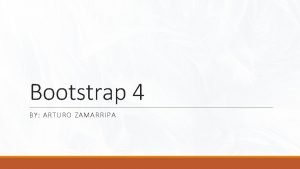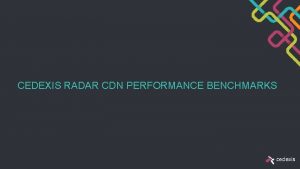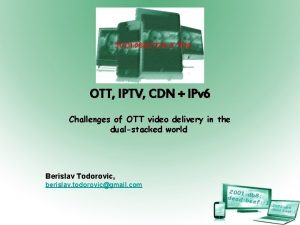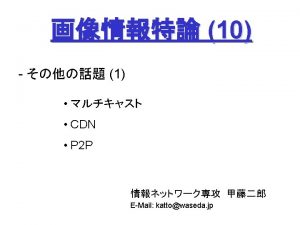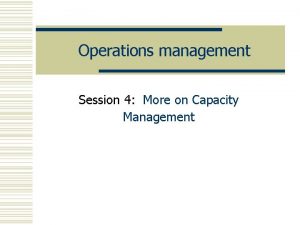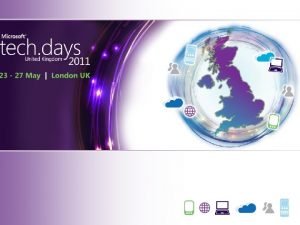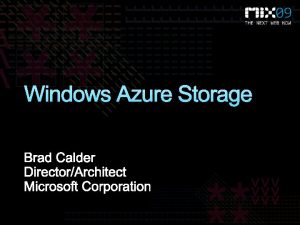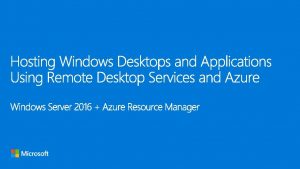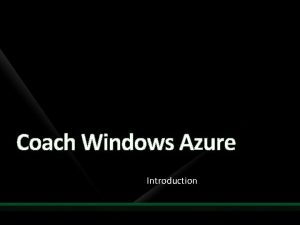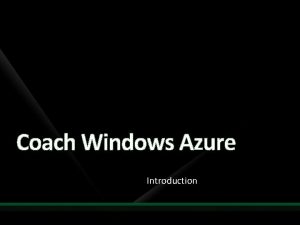Azure CDN Utilization of Azure CDN for the














- Slides: 14

Azure CDN Utilization of Azure CDN for the large file distribution Azure CDN POC results has been captured in this PPT WHYAZURE © 2017 Aavisek Choudhury. Whyazure. in 1

Agenda • • Azure CDN Features How CDN Works Azure CDN Pricing Azure CDN Advantages and Security How to token Authentication work POC 1 and POC 2 Results Next Steps 2

Azure CDN Features of Azure CDN • Azure CDN has been used for delivering high bandwidth content that is stored in Azure or other location. • The major advantages of using the CDN are lower latency and faster delivery of content to users irrespective of their geographical location in relation to the datacenter where the content is hosted. • The CDN is typically used for delivering static content such as images, style sheets, documents, files, client-side scripts, and HTML pages. • Using the CDN should also help to reduce the load on application because it is relieved of the processing required to access and deliver the content. This reduction in load can help to increase the performance and scalability of the application, as well as minimizing hosting costs by reducing the processing resources required to achieve a specific level of performance and availability. • The CDN can deliver content over HTTPS (SSL) using the certificate provided by the CDN, but it will also be available over HTTP as well. In our demo we have used secure content over HTTPS(Port 443). 3

How it works User (Andy) Point of Presence (POP) CDN EDGE SERVERS Origin Azure Blob Storage Other Users 1. A user (Andy) requests a file (also called an asset) using a URL with a special domain name, such as <endpointname>. azureedge. net. DNS routes the request to the best performing Point-of-Presence (POP) location. Usually this is the POP that is geographically closest to the user. 2. If the edge servers in the POP do not have the file in their cache, the edge server requests the file from the origin. The origin can be an Azure Web App, Azure Cloud Service, Azure Storage account, or any publicly accessible web server. 3. The origin returns the file to the edge server, including optional HTTP headers describing the file's Time-to-Live (TTL). 4. The edge server caches the file and returns the file to the original requestor (Andy). The file remains cached on the edge server until the TTL expires. If the origin didn't specify a TTL, the default TTL is seven days. 5. Additional users may then request the same file using that same URL, and may also be directed to that same POP. 6. If the TTL for the file hasn't expired, the edge server returns the file from the cache. This results in a faster, more responsive user experience. 4

Azure CDN Pricing CDN Zone Price for 1 TB (Std. (Premium. Verizon) Zone 1 (North America, Europe) $ 174. 08 Per Month $ 89. 09 Per Month Zone 2(Asia Pacific, $ 256. 00 Per Month Japan) $ 141. 31 Per Month Zone 3(Brazil) $ 512. 00 Per Month $ 256. 00 Per Month Zone 4(Australia) $ 286. 72 Per Month $ 143. 36 Per Month Zone 5(India) $ 348. 16 Per Month $ 174. 08 Per Month Note: Additional Azure Blob Storage (LRS) price for 250 GB at East US will cost $ 6. 00 Per Month. A discount up to 25% can be applicable based on EA or CSP. 5

Azure CDN – Advantages and Security The Azure Content Delivery Network (CDN) caches static web content at strategically placed locations to provide maximum throughput for delivering content to users. The users will generally receive the content from it’s nearest location. The EDGE servers (Point of Presence) is distributed across the globe to meet this need. Azure CDN Provides the following benefits. • • Better performance and user experience for end users, especially when using applications where multiple round-trips are required to load content. Large scaling to better handle instantaneous high load, like at the start of a product launch event. By distributing user requests and serving content from edge servers, less traffic is sent to the origin. Security can be achieved by deploying token authentication. The token authentication is a mechanism that allows to prevent Azure CDN from serving assets to unauthorized clients. This is typically done to prevent "hotlinking" of content, where a different website, often a message board, uses your assets without permission. This can have an impact on the content delivery costs. By enabling this feature on CDN, requests will be authenticated by CDN edge POPs before delivering the content. Token authentication is only available with Verizon Premium Storage Tier. 6

Securing Azure CDN Asset with token Authentication- How it works • Token authentication verifies requests are generated by a trusted site by requiring requests to contain a token value containing encoded information about the requester. Content will only be served to requester when the encoded information meet the requirements, otherwise requests will be denied. You can set up the requirement using one or multiple parameters below. • Country: allow or deny requests that originated from specified countries. • URL: only allow specified asset or path to request. • Host: allow or deny requests using specified hosts in the request header. • Referrer: allow or deny specified referrer to request. • IP address: only allow requests that originated from specific IP address or IP subnet. • Protocol: allow or block requests based on the protocol used to request the content. • Expiration time: assign a date and time period to ensure that a link only remains valid for a limited time period. 7

POC 1 Target: We will measure and compare the download time of the standard Unisys logo and one ZIP file from a website. Components Used: • Azure Blob Storage. • Azure CDN Profile. Approach: We have created the CDN profile called Software. Distribution based on East US region of Azure. The CDN is based on Verizon Standard Pricing Tire. The data has been hosted in the Azure Blob Storage. The website is hosted in a Client Workstation in India. 8

Test Results The first result of Azure CDN shows the following (For the 8. 2 KB of Unisys Logo) Image downloaded from Azure Blob Storage Image downloaded from CDN ZIP file downloaded from Azure Blob Storage ZIP file downloaded from CDN 9

Comparison of results Download Item Direct Blob Storage CDN End Point Company Logo 1170 MS 481 MS ZIP File 274 MS 152 MS Unisys logo download is 44% faster with CDN, if we access the CDN frequently the download time has gone up to 60 Sec. Similarly ZIP file download is 58. 8% faster through CDN. 10

POC 2 Target: We will measure and compare the download time of the Visio 2007 software from Azure Web App. Components Used: • Azure Blob Storage. • Azure CDN Profile. • Azure Web Approach: We have created the CDN profile called WHYAZURECDN based on Central US region of Azure. The CDN is based on Verizon Standard Pricing Tire. The data has been hosted in the Azure Blob Storage. The website is hosted in the App Service of the East US region of Azure. 11

Comparison of results Download Item File Size (MB) Visio 2007 ZIP File 385 MB CDN End Point (Time) Direct Blob Storage (Time) 2 Min. 26 Sec. 64 Ms. 6 Min. 48 Sec. 79 Ms. Visio 2007 download is almost three times faster with CDN, both the download were made from my office in Bangalore. And the user is in the LAN. 12

Next Steps • This is the end of POC, the next step will be assign a. net developer to develop the security module of the token authentication and integrate with Azure Active Directory. 13

Thank You 14
 Microsoft azure cdn pricing
Microsoft azure cdn pricing Azure erdrich
Azure erdrich Zozhnik india
Zozhnik india Cdn architectures
Cdn architectures Https //fontawesome.bootstrapcheatsheets.com cdn
Https //fontawesome.bootstrapcheatsheets.com cdn Cedexis cdn
Cedexis cdn 12112336 pix cdn org m p 0 83 83878 hevtgvi2 html
12112336 pix cdn org m p 0 83 83878 hevtgvi2 html Cdn for iptv
Cdn for iptv Cdn free
Cdn free Apache traffic server
Apache traffic server Cube utilization formula
Cube utilization formula Medication utilization evaluation
Medication utilization evaluation Litmus milk decolorization test
Litmus milk decolorization test Energy definition
Energy definition Utilization rate operations management
Utilization rate operations management




